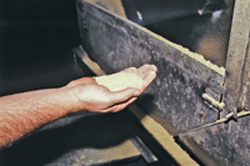
Features
Agronomy
Soil
Canola withstands waterlogged soils surprisingly well
Early season flooding hurts yield more.
November 23, 2007 By Bruce Barker
In 2007, many areas of Manitoba, southeastern, north-central and northeastern Saskatchewan, and central Alberta between Didsbury and Ponoka suffered from excess moisture that caused flooding in low spots in June. And later in the season, heavy rains in northern Saskatchewan including Saskatoon, which saw four inches of rain in mid August, also caused concern. As a result, the flooding led to questions of how standing water affects yields.
 “Depending on the stage of crop development, the symptoms that occurred are commonly called the
“Depending on the stage of crop development, the symptoms that occurred are commonly called the
‘wet feet syndrome’,” says agronomy specialist, David Vanthuyne with the Canola Council of Canada at Watrous, Saskatchewan.
Vanthuyne explains that early
growth stages of canola are the most susceptible to flooding. Wet soils slow down or stop gas exchange between the soil and atmosphere, causing an oxygen deficiency, reducing root respiration and plant growth. He explains that the plants look like they have become deficient in nitrogen (N) or sulphur (S) because the symptoms include changes in plant colour such as yellowing or purpling, stunted growth, premature bolting (small and spindly canola plants that are starting to bolt) and older leaves turning purple and maturing more rapidly.
“In a sense, they are nutrient deficient because the roots are not functioning properly due to the lack of oxygen, so they can’t take up the nutrients they need,” explains Vanthuyne.
The extent to which canola will suffer vegetative growth restrictions and yield loss depends on crop growth stage at the time of waterlogging, soil type and texture, duration of saturated soil and temperature. High temperatures combined with waterlogged soils may reduce yields further because the higher temperatures cause higher respiration rates in roots and soil micro-organisms, causing soil oxygen to be depleted even more quickly.
 Young canola is quite susceptible to waterlogging and yield reductions of 20 percent can occur after only three days of flooding at the early rosette growth stage. Waterlogging for seven days at the rosette growth stage can reduce plant height, and the number of branches and seeds per pod may also decrease with three days or more of flooding. Waterlogging for three days or more during flowering reduces the number of pods per branch as well as seeds per pod.
Young canola is quite susceptible to waterlogging and yield reductions of 20 percent can occur after only three days of flooding at the early rosette growth stage. Waterlogging for seven days at the rosette growth stage can reduce plant height, and the number of branches and seeds per pod may also decrease with three days or more of flooding. Waterlogging for three days or more during flowering reduces the number of pods per branch as well as seeds per pod.
At later stages, yield losses are not as dramatic, with a canola crop at the seed filling stage losing slightly less than 10 percent of yield after three days of flooding. Waterlogging for seven days at seed filling decreases individual seed weight and oil content. High temperatures combined with waterlogging increase the detrimental effects on canola yield.
Soil texture also comes into play. Coarser soils can hold more oxygen, increasing the amount of time required for anaerobic conditions to develop, so the crop may be able to tolerate flooding for a longer period of time. On the other hand, coarser soils are more susceptible to nutrient leaching.
Any remedial action possible?
For early growth stages, after the excess moisture drains away, the most immediate concern is the fertility level of N and S, as both are mobile in the soil and may have been leached out of the soil. Vanthuyne recommends that growers allow the crop to recover before assessing whether or not additional nutrients may need to be top dressed.
Canola Council information shows that canola can respond well to top dressed sulphate fertilizer right up to bolting and early flower, while economic responses to nitrogen are most likely to occur if top dressing is done prior to the four to six leaf stage.
“You may be able to top dress, but if the plant is starting to flower, it may be too late for nitrogen,” says Vanthuyne. “And if there is still excess moisture, the plant won’t be able to take up the nutrients because of the anaerobic conditions.”
Ultimately, aside from pumping out excess water, a farmer cannot do a lot to deal with waterlogged soils after excessive rains. However, the yield loss data can provide a guideline to help decide if areas of the field that are prone to flooding should have mechanical drainage installed to reduce flooding in future years.